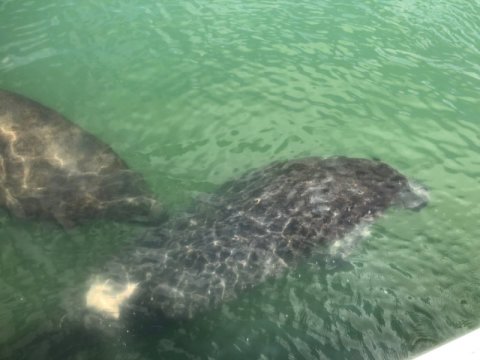[ad_1]
A new publication in the journal Frontiers in Marine Science tracks West Indian manatee movements through nearshore and offshore ship channels in the north-central Gulf of Mexico. The publication, “Linking Use of Ship Channels by West Indian Manatees (Trichechus manatus) to Seasonal Migration and Habitat Use,” provides new fundamental knowledge on movement ecology of a large, protected marine species and important information to guide future conservation practices.
The work synthesizes 10 years of data collected by researchers at the Dauphin Island Sea Lab from satellite tracking, citizen-sourced sightings, and environmental attributes linked to manatee movements.
During migration, manatees have the potential to travel through a wide range of channel types and are exposed to a diversity of vessel types, including recreational boats, shrimp trawlers, barges, and large container ships. By understanding manatee movement patterns, we can better aid risk assessment for vessel collision and other shipping related activities for migratory marine species globally.
“More and more manatees are coming up from Florida during the summer time and using these ship channels as travel corridors. This means there’s more of a chance they’ll cross paths with a vessel of some kind, which makes them more vulnerable to boat strikes,” said post-doctoral researcher Carl Cloyed. “By knowing when they are using these channels the most, we can suggest the best times for channel maintenance and give recreational and commercial boaters a better idea of when they may encounter a manatee during the year.”
Manatees travel in both nearshore boat channels (i.e. rivers, canals, and estuaries) and open water fairways (i.e. Mobile Bay Ship Channel), but were found to use nearshore channels more frequently. Satellite-tracked manatees swam faster and moved more directly in all channel types, indicating these channels as migratory and travel corridors. In estuaries and rivers, manatees traveled north and south, consistent with movement among foraging habitats and other essential resources.
The approach used in this study can be applied to a wider range of species among locations to help predict when and how marine megafauna use ship channels and to evaluate risks associated with channel use.
This work was supported by the National Science Foundation, the State of Alabama, and other independent agencies.
Story Source:
Materials provided by Dauphin Island Sea Lab. Note: Content may be edited for style and length.
[ad_2]















